Abstract
The correlation between dental caries and the number of oral mutans group streptococci (ms) present has been shown to be weak. The aim of this investigation was to study associations between caries experience (decayed, missing, and filled surfaces [dmfs]) and the number of ms in stimulated saliva, with emphasis on the level of disease and the confounding effect of regular intake of sweets, the presence of salivary lactobacilli, and oral hygiene. In some 2,700 4- to 5-year-old South African children of different ethnic origins, caries was diagnosed on the basis of World Health Organization criteria and saliva samples were analyzed for ms after cultivation on mitis salivarius-bacitracin agar and for lactobacilli by using the Dentocult kit. Oral hygiene was scored on the basis of the Greene and Vermillion simplified debris index, while data on intake of sweets were derived from extensive interviews. Pearson's coefficient of correlation was computed, and multiple regression analysis was performed to correct for confounding factors. The distribution of the children in the eight caries classes was strongly associated with the ms class (P < 0.001), with those in the lower ms classes generally having low dmfs scores and those in the higher ms classes having dmfs scores distributed over the whole range. The r value for the two variables was 0.25 for the total material; this was reduced to 0.18 by correction for confounding factors. The corresponding values for children with caries were 0.21 and 0.17, for those in the 1 to 6 dmfs interval they were 0.07 and 0.03, and for those in the 7 to 81 dmfs interval they were 0.16 and 0.14. The data imply that the explanatory values for ms, those for the lower caries interval not counted, ranged from 6 to 2%. The unexpected results for children with caries might be due to their distribution pattern. It is concluded that there is a need for reevaluation of ms as a risk factor in dental caries.
Full text
PDF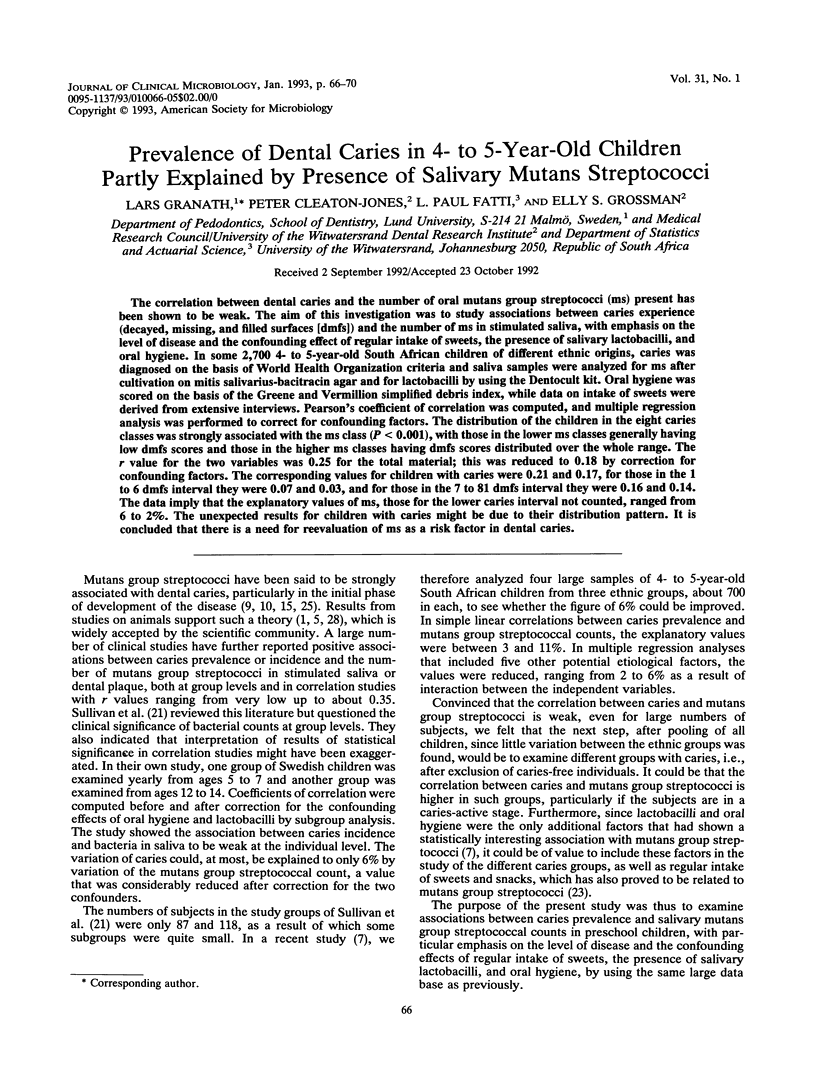
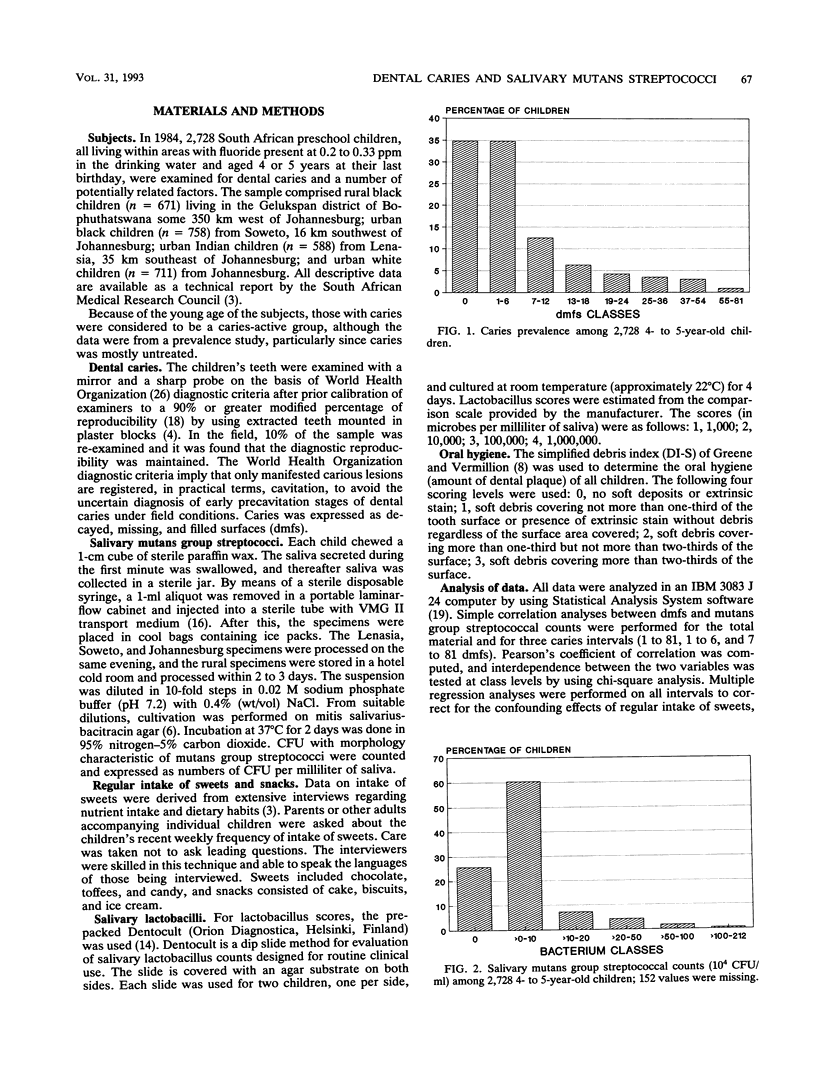
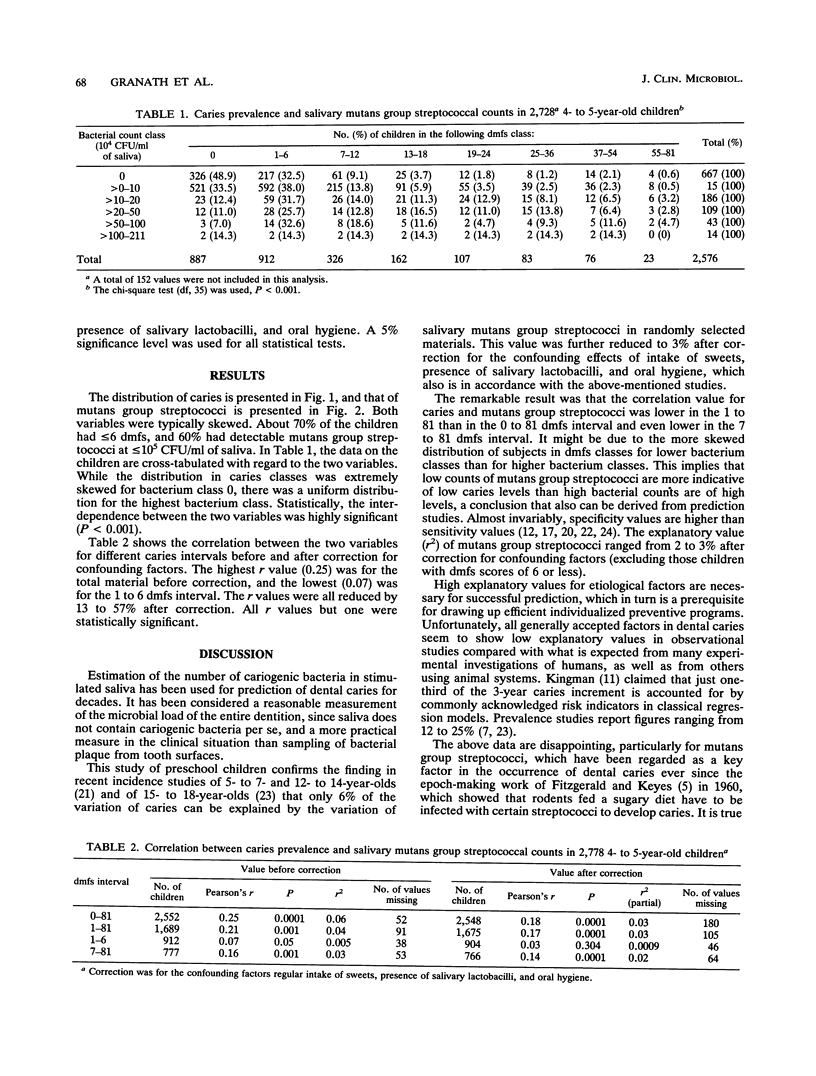
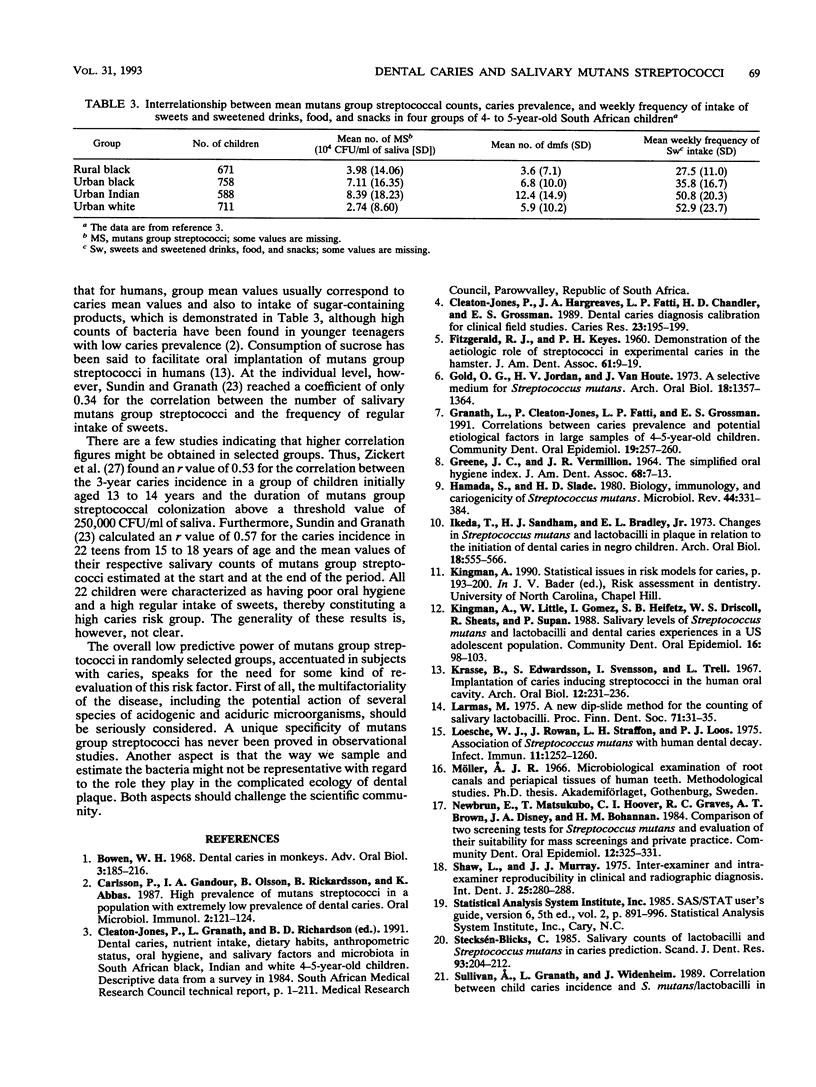
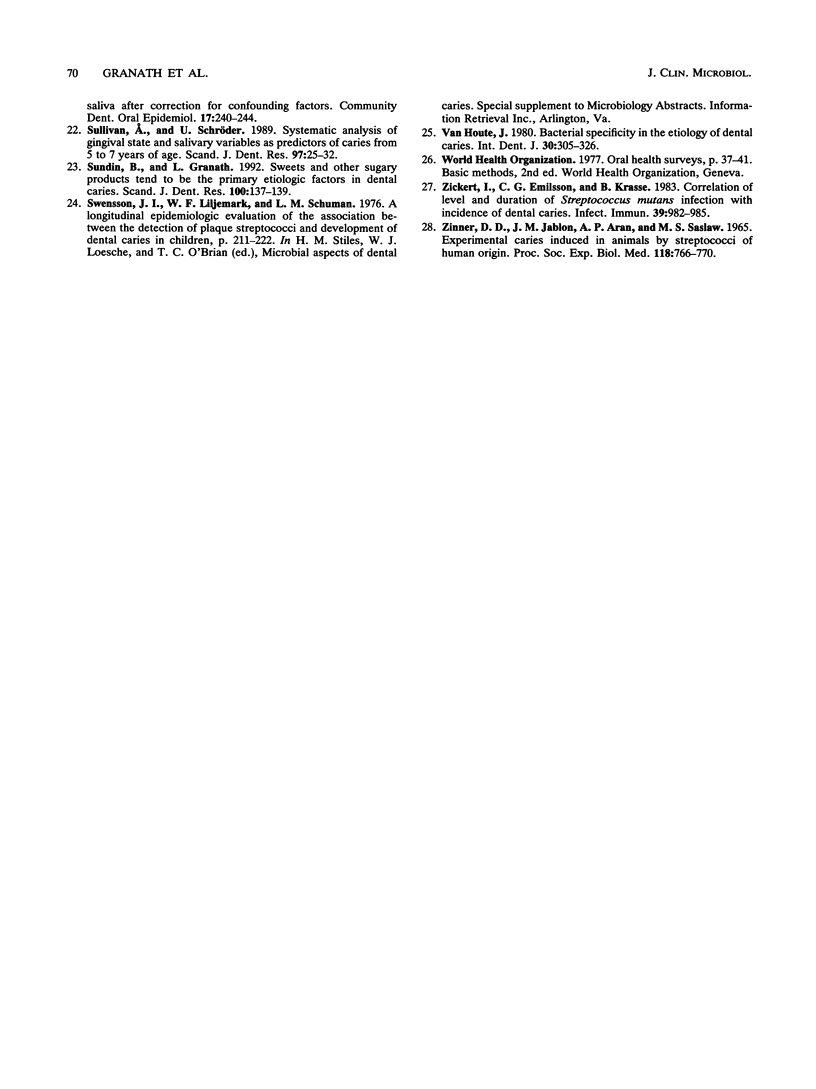
Selected References
These references are in PubMed. This may not be the complete list of references from this article.
- Bowen W. H. Dental caries in monkeys. Adv Oral Biol. 1968;3:185–216. doi: 10.1016/b978-1-4832-3119-8.50013-5. [DOI] [PubMed] [Google Scholar]
- Carlsson P., Gandour I. A., Olsson B., Rickardsson B., Abbas K. High prevalence of mutans streptococci in a population with extremely low prevalence of dental caries. Oral Microbiol Immunol. 1987 Sep;2(3):121–124. doi: 10.1111/j.1399-302x.1987.tb00274.x. [DOI] [PubMed] [Google Scholar]
- Cleaton-Jones P., Hargreaves J. A., Fatti L. P., Chandler H. D., Grossman E. S. Dental caries diagnosis calibration for clinical field surveys. Caries Res. 1989;23(3):195–199. doi: 10.1159/000261177. [DOI] [PubMed] [Google Scholar]
- FITZGERALD R. J., KEYES P. H. Demonstration of the etiologic role of streptococci in experimental caries in the hamster. J Am Dent Assoc. 1960 Jul;61:9–19. doi: 10.14219/jada.archive.1960.0138. [DOI] [PubMed] [Google Scholar]
- GREENE J. C., VERMILLION J. R. THE SIMPLIFIED ORAL HYGIENE INDEX. J Am Dent Assoc. 1964 Jan;68:7–13. doi: 10.14219/jada.archive.1964.0034. [DOI] [PubMed] [Google Scholar]
- Gold O. G., Jordan H. V., Van Houte J. A selective medium for Streptococcus mutans. Arch Oral Biol. 1973 Nov;18(11):1357–1364. doi: 10.1016/0003-9969(73)90109-x. [DOI] [PubMed] [Google Scholar]
- Granath L., Cleaton-Jones P., Fatti P., Grossman E. Correlations between caries prevalence and potential etiologic factors in large samples of 4-5-yr-old children. Community Dent Oral Epidemiol. 1991 Oct;19(5):257–260. doi: 10.1111/j.1600-0528.1991.tb00162.x. [DOI] [PubMed] [Google Scholar]
- Hamada S., Slade H. D. Biology, immunology, and cariogenicity of Streptococcus mutans. Microbiol Rev. 1980 Jun;44(2):331–384. doi: 10.1128/mr.44.2.331-384.1980. [DOI] [PMC free article] [PubMed] [Google Scholar]
- Ikeda T., Sandham H. J., Bradley E. L., Jr Changes in Streptococcus mutans and lactobacilli in plaque in relation to the initiation of dental caries in Negro children. Arch Oral Biol. 1973 Apr;18(4):555–566. doi: 10.1016/0003-9969(73)90076-9. [DOI] [PubMed] [Google Scholar]
- Kingman A., Little W., Gomez I., Heifetz S. B., Driscoll W. S., Sheats R., Supan P. Salivary levels of Streptococcus mutans and lactobacilli and dental caries experiences in a US adolescent population. Community Dent Oral Epidemiol. 1988 Apr;16(2):98–103. doi: 10.1111/j.1600-0528.1988.tb01852.x. [DOI] [PubMed] [Google Scholar]
- Krasse B., Edwardsson S., Svensson I., Trell L. Implantation of caries-inducing streptococci in the human oral cavity. Arch Oral Biol. 1967 Feb;12(2):231–236. doi: 10.1016/0003-9969(67)90042-8. [DOI] [PubMed] [Google Scholar]
- Larmas M. A new dip-slide method for the counting of salivary lactobacilli. Proc Finn Dent Soc. 1975 Apr;71(2):31–35. [PubMed] [Google Scholar]
- Loesche W. J., Rowan J., Straffon L. H., Loos P. J. Association of Streptococcus mutants with human dental decay. Infect Immun. 1975 Jun;11(6):1252–1260. doi: 10.1128/iai.11.6.1252-1260.1975. [DOI] [PMC free article] [PubMed] [Google Scholar]
- Newbrun E., Matsukubo T., Hoover C. I., Graves R. C., Brown A. T., Disney J. A., Bohannan H. M. Comparison of two screening tests for Streptococcus mutans and evaluation of their suitability for mass screenings and private practice. Community Dent Oral Epidemiol. 1984 Oct;12(5):325–331. doi: 10.1111/j.1600-0528.1984.tb01464.x. [DOI] [PubMed] [Google Scholar]
- Shaw L., Murray J. J. Inter-examiner and intra-examiner reproducibility in clinical and radiographic diagnosis. Int Dent J. 1975 Dec;25(4):280–288. [PubMed] [Google Scholar]
- Stecksén-Blicks C. Salivary counts of lactobacilli and Streptococcus mutans in caries prediction. Scand J Dent Res. 1985 Jun;93(3):204–212. doi: 10.1111/j.1600-0722.1985.tb01946.x. [DOI] [PubMed] [Google Scholar]
- Sullivan A., Schröder U. Systematic analysis of gingival state and salivary variables as predictors of caries from 5 to 7 years of age. Scand J Dent Res. 1989 Feb;97(1):25–32. doi: 10.1111/j.1600-0722.1989.tb01427.x. [DOI] [PubMed] [Google Scholar]
- Sundin B., Granath L. Sweets and other sugary products tend to be the primary etiologic factors in dental caries. Scand J Dent Res. 1992 Jun;100(3):137–139. doi: 10.1111/j.1600-0722.1992.tb01728.x. [DOI] [PubMed] [Google Scholar]
- ZINNER D. D., JABLON J. M., ARAN A. P., SASLAW M. S. EXPERIMENTAL CARIES INDUCED IN ANIMALS BY STREPTOCOCCI OF HUMAN ORIGIN. Proc Soc Exp Biol Med. 1965 Mar;118:766–770. doi: 10.3181/00379727-118-29964. [DOI] [PubMed] [Google Scholar]
- Zickert I., Emilson C. G., Krasse B. Correlation of level and duration of Streptococcus mutans infection with incidence of dental caries. Infect Immun. 1983 Feb;39(2):982–985. doi: 10.1128/iai.39.2.982-985.1983. [DOI] [PMC free article] [PubMed] [Google Scholar]
- van Houte J. Bacterial specificity in the etiology of dental caries. Int Dent J. 1980 Dec;30(4):305–326. [PubMed] [Google Scholar]


